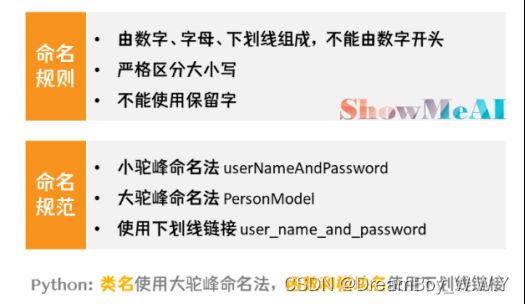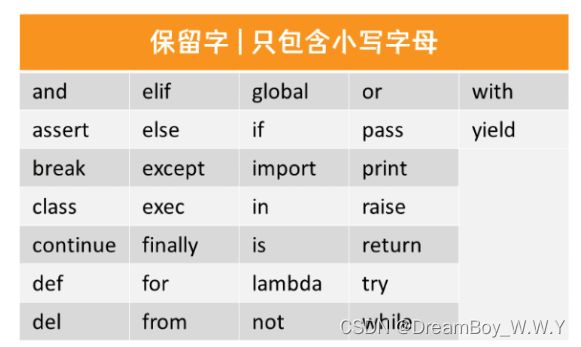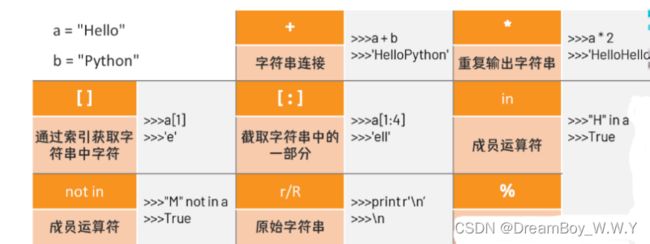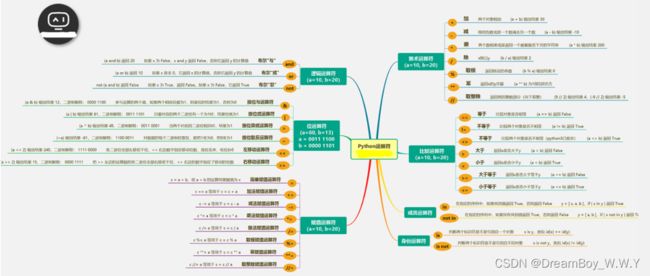【python】--python基础学习
目录
- 一、基础语法
- 二、基础数据类型
-
- 1、变量赋值
- 2、数值型
- 3、字符串型
- 4、列表List
- 5、元组Tuple
- 6、字典dictionary
- 7、数据类型转换
- 三、python运算符
- 四、条件控制与循环
- 五、常用函数
-
- 1、字符串函数
- 2、format函数
一、基础语法
标识符是允许作为变量(函数、类等)名称的有效字符串。

python保留字符

行和缩进

多行语句
使用斜杠( \)将一行的语句分为多行显示,例如
total = item_one +
item_two +
item_three
语句中包含 [], {} 或 () 括号就不需要使用多行连接符,如
days = [‘Monday’, ‘Tuesday’, ‘Wednesday’,
‘Thursday’, ‘Friday’]
字符串与引号
Python 可以使用引号(?‘?)、双引号(?“?)、三引号(?‘’’?或?“””?) 来表示字符串,引号的开始与结束必须是相同类型的。
例如:
word = ‘word’
sentence = “这是ShowMeAI的教程。”
paragraph = “”“这是包含多行的语句。
有一行包含了ShowMeAI”“”
注释
单行注释采用?#?开头;
多行注释使用三个单引号(‘’’)或三个双引号(“””);
print输出
python3中print默认输出是换行的,如果要实现不换行需要在变量末尾加上 「, end=’’」。
s = set([1, 1, 2, 2, 3, 3])
a = ‘abc’
print(s, end=‘’)
print(a, end=‘’)
#输出结果是 {1, 2, 3}abc
二、基础数据类型
Python基本数据类型一般分为6种:数值(Numbers)【int有符号整型、float浮点型、bool布尔型、complex复数】、字符串(String)、列表(List)、元组(Tuple)、字典(Dictionary)、集合(Set)。
1、变量赋值
num = 100 # 赋值整型变量
weight = 100.0 # 浮点型
name = “ShowMeAI” # 字符串
a = b = c = 1 #a,b,c各自都有了1
a, b, c = 1, 2, “ShowMeAI” #a为1,b为2,c为"ShowMeAI"
2、数值型
3、字符串型
从左到右索引默认0开始的,最大范围是字符串长度少1
从右到左索引默认-1开始的,最大范围是字符串开头

print(s[0]) #S
print(s[:1]) #S 说明:[,1) 从起始index开始,到index=1下标结束
print(s[2:5]) #owM 说明:[2,5)范围中,全部输出
print(s[2:]) #owMeAI 说明:[2,)范围中,全部输出
print(s[:3:]) #Sho 说明:[0,3)范围中,全部输出
print(s[1:4:1]) #how 说明:[1,4)范围中,步长1截取数据
print(s[1:4:2]) #hw 说明:[1,4)范围中,以步长2截取数据,从index=1开始,输出第二个数和前一个数的index差2
print(s2) #ShowMeAIShowMeAI 说明:输出两次
print(s[0]) #S
print(s[:1]) #S 说明:[,1) 从起始index开始,到index=1下标结束
print(s[2:5]) #owM 说明:[2,5)范围中,全部输出
print(s[2:]) #owMeAI 说明:[2,)范围中,全部输出
print(s[:3:]) #Sho 说明:[0,3)范围中,全部输出
print(s[1:4:1]) #how 说明:[1,4)范围中,步长1截取数据
print(s[1:4:2]) #hw 说明:[1,4)范围中,以步长2截取数据,从index=1开始,输出第二个数和前一个数的index差2
print(s2) #ShowMeAIShowMeAI 说明:输出两次
4、列表List
列表支持字符,数字,字符串甚至可以包含列表(即嵌套)。
列表用[ ]标识,是 python 最通用的复合数据类型。
列表中值的切割也可以用到变量[头下标:尾下标],就可以截取相应的列表,从左到右索引默认 0 开始,从右到左索引默认 -1 开始,下标可以为空表示取到头或尾。
list = ['ShowMeAI', 786, 2.23,[123, 'show'], 'show', 70.2,54,[6.5, 'ww']]
print(list[0]) #ShowMeAI 说明:得到的是字符串
print(list[:1]) #['ShowMeAI'] 说明: [0,1)范围的列表
print(list[2:5]) #[2.23, [123, 'show'], 'show'] 说明:[2,5)范围的列表
print(list[2:]) #[2.23, [123, 'show'], 'show', 70.2, 54, [6.5, 'ww']] 说明:[2,*)范围的列表
print(list[:3:]) #['ShowMeAI', 786, 2.23] 说明:[0,3)范围所有数据的列表
print(list[1:4:1]) #[786, 2.23, [123, 'show']] 说明:[1,4)范围,步长为1的列表
print(list[1:4:2]) #[786, [123, 'show']] 说明:[1,4)范围,步长为2的列表
for te in list:
print('当前值:%s' % te)
for index in range(len(list)):
print('当前值index:%s' % list[index])
if (786 not in list):
print("786不在列表list 中")
else:
print("786在变列表list 中")
5、元组Tuple
元组用()标识。内部元素用逗号隔开。但是元组不能二次赋值,相当于只读列表。
tuple=('ShowMeAI', 786, 2.23,(123, 'show'), 'show', 70.2,54,[6.5, 'ww'])
print(tuple[0]) # ShowMeAI 说明:得到的是字符串
print(tuple[:1]) # ('ShowMeAI',) 说明: [0,1)范围的元组
print(tuple[2:5]) # (2.23, (123, 'show'), 'show') 说明:[2,5)范围的元组
print(tuple[2:]) # (2.23, (123, 'show'), 'show', 70.2, 54, [6.5, 'ww']) 说明:[2,*)范围的元组
print(tuple[:3:]) # ('ShowMeAI', 786, 2.23) 说明:[0,3)范围所有数据的元组
print(tuple[1:4:1]) # (786, 2.23, (123, 'show')) 说明:[1,4)范围,步长为1的元组
print(tuple[1:4:2]) # (786, (123, 'show')) 说明:[1,4)范围,步长为2的元组
6、字典dictionary
是无序的对象集合,字典当中的元素是通过键来存取的。用”{ }”标识。字典由索引(key)和它对应的值value组成
dict={}
dict['one']='wwq'
dict[2]="rqq21"
dict['two']=[123, 'show']
dict['one'] = (5.4, 'dest')
tinydict = {'name': 'ShowMeAI', 'code': 3456, 'dept': 'AI'}
print(dict) #{'one': (5.4, 'dest'), 2: 'rqq21', 'two': [123, 'show']}
print(dict[2]) # rqq21
print(dict['one']) # (5.4, 'dest')
print(dict.keys()) # dict_keys(['one', 2, 'two'])
print(dict.values()) # dict_values([(5.4, 'dest'), 'rqq21', [123, 'show']])
print(tinydict.keys()) # dict_keys(['name', 'code', 'dept'])
print(tinydict.values()) # dict_values(['ShowMeAI', 3456, 'AI'])
7、数据类型转换
print(int(10.3)) #10
print(float(109)) #109.0
x = [123, 'show']
print(tuple(x)) #(123, 'show')
print(list(x)) #[123, 'show']
三、python运算符
list = ['ShowMeAI', 786, 2.23,[123, 'show'], 'show', 70.2,54,[6.5, 'ww']]
if (786 not in list):
print("786不在列表list 中")
else:
print("786在变列表list 中")
b = "Python"
if ("M" not in a):
print("M 不在变量 a 中")
else:
print("M 在变量 a 中")
四、条件控制与循环
if 语句可以细分为三种形式: if 语句、if else 语句和 if elif else 语句。
在 python 中,while … else 在循环条件为 false 时执行 else 语句块,例如
count = 0
while count < 5:
print(count, "比5要小")
count = count + 1
else:
print(count, "不比5小")
for循环
list = ['ShowMeAI', 786, 2.23,[123, 'show'], 'show', 70.2,54,[6.5, 'ww']]
for te in list:
print('当前值:%s' % te)
for index in range(len(list)):
print('当前值index:%s' % list[index])
string字符串
s = 'ShowMeAI'
for te in s:
print('当前值:%s' % te)
五、常用函数
1、字符串函数
aStr=' ajqj11akjqk1'
print("capitalize:"+aStr.capitalize()) #capitalize: ajqj11akjqk1
print("center:"+aStr.center(20)) #center: ajqj11akjqk1
print("count: %d" % aStr.count('a', 0, len(aStr))) #count: 2
print("decode:"+aStr.encode('utf-8').decode('utf-8')) #decode: ajqj11akjqk1
print(aStr.endswith('3', 0, len(aStr))) #False
print("find:%d" % aStr.find('ak', 0, len(aStr))) #find:7
print("index:%d" % aStr.index('ak', 0, len(aStr))) #不在会抛异常 index:7
print(aStr.isalnum()) #index:7
print(aStr.isalpha()) #False
print(aStr.isdecimal()) #False
print(aStr.isdigit()) #False
print(aStr.islower()) #True
print(aStr.isnumeric()) #False
print(aStr.isspace()) #False
print(aStr.istitle()) #False
print(aStr.isupper()) #False
bStr = 'f'
seq=['a1','a2']
print("join:" + bStr.join(seq)) # join:a1fa2 以 string 作为分隔符,将 seq 中所有的元素(的字符串表示)合并为一个新的字符串
print("lower:" + aStr.lower()) #lower: ajqj11akjqk1
print("lstrip:" + aStr.lstrip()) #lstrip:ajqj11akjqk1
print("max:" + max(aStr)) #max:q
2、format函数
print("{:.2f}".format(3.1415926)) #保留小数点后两位 3.14
print("{:+.2f}".format(3.1415926)) #带符号保留小数点后两位 +3.14
print("{:-.2f}".format(3.1415926)) # 3.14
print("{:+.2f}".format(-1)) #带符号保留小数点后两位 -1.00
print("{:.0f}".format(2.71828)) #不带小数 3
print("{:0>2d}".format(5)) #数字补零 (填充左边, 宽度为2) 05
print("{:x<4d}".format(11)) #数字补x (填充右边, 宽度为4) 11xx
print("{:,}".format(1000000)) #以逗号分隔的数字格式 1,000,000
print("{:.2%}".format(0.25)) #百分比格式 25.00%
print("{:.2e}".format(1000000000)) #指数记法 1.00e+09
print("{:>10d}".format(13)) #右对齐 (默认, 宽度为10) ' 13'
print("{:<10d}".format(13)) #左对齐 (宽度为10) '13 '
print("{:^10d}".format(13)) #中间对齐 (宽度为10) ' 13 '
print('{:x}'.format(11)) #进制 b



